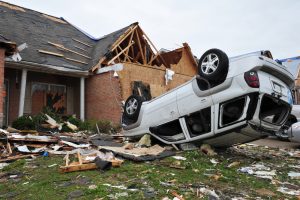Back to Basics is a weekly feature that highlights important but possibly overlooked information that any EHS professional should know. This week, we examine how to prepare for a tornado.
Severe weather events are seemingly commonplace these days, but there’s something particularly devastating about tornadoes. Especially the unpredictability and the sheer damage they can dish out. Despite their unpredictable nature of tornadoes, businesses can take steps to prepare for the storms and their aftermath.
The Occupational Safety and Health Administration (OSHA) and the National Oceanic and Atmospheric Administration (NOAA) have teamed to provide resources on tornado preparedness. This includes developing an emergency plan that details suitable places to take shelter, policies to ensure all employees are accounted for, and procedures for dealing with any on-site hazardous materials.
Your planning efforts should include training and exercises so that you and your employees know where to find shelter and are familiar with your community’s warning system. You may need to acquire additional equipment such as emergency supply kits and other resources identified in your emergency plan.
Shelter
Identifying shelter locations is crucial to tornado preparedness. If you don’t have an underground area such as a basement or storm cellar, consider the following alternatives:
- A small interior room or hallway on the lowest possible floor
- Stay away from doors, windows, and outside walls
- Stay in the center of the room and avoid corners because they can attract debris
- Rooms built with reinforced concrete, brick, or block with no windows and a heavy concrete floor or roof system overhead
- Avoid auditoriums, cafeterias, and gymnasiums that have flat, wide-span roofs
Know what to do
If caught outdoors when a tornado is threatening, employees should seek shelter in a basement or sturdy building. If one cannot be found within walking distance, drive to the nearest shelter. If you encounter flying debris while in a vehicle, either stay in the vehicle with seat belt on and your head below the windows, or find an area that is lower than the roadway and lie in it while covering your head with your hands.
Accountability
OSHA recommends these steps to ensure the safety of personnel in a tornado:
- Develop a system for knowing who is in the building in the event of an emergency.
- Establish an alarm system to warn workers. Test the system frequently and develop plans to communicate warnings to personnel with disabilities or who do not speak English.
- Account for workers, visitors, and customers as they arrive in the shelter using a prepared roster or checklist and taking a head count.
- Assign specific duties to workers in advance with checklists for each specific responsibility. Designate and train alternates in case the assigned person is not there or injured.
For more tornado preparedness guidance, visit the Centers for Disease Control and Prevention and the Federal Emergency Management Agency.

